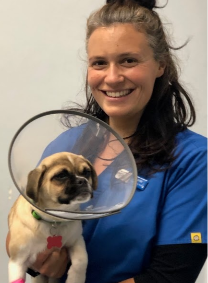
Protecting Sutures and Wounds
Whether it's a desexing procedure or a stitch-up after an accident, many pets will require some form of wound and suture management at least once in their lifetime. Even wounds without external sutures still need to be given time to heal.
It is a shame when healing is delayed due to a pet's 'intervention'. Licking, biting at sutures, chewing off bandages, rubbing tummies along the ground and too much bouncy play can all contribute to delayed wound healing.
Even calm and quiet pets are inclined to nibble at the incision or bandage.
There are many ways to help protect wounds and sutures:
Elizabethan Collars
These are plastic lampshade-shaped collars, which slip over your pet's head and attach to its own collar. They are usually transparent and well tolerated, although there will be a period of adjustment as your pet becomes accustomed to its new width! Expect backwards walking and doorway crashing initially. Make sure your pet can access its food and water whilst wearing the collar. In an emergency, a bucket or a flower pot with the bottom cut out can make a temporary Elizabethan collar.

- Food and water bowls should be shallow and smaller in diameter to the cone
- Place the bowls away from walls
- Try elevating the bowls on a stand such as a footstool
Pain Relief
Pets often lick or worry at wounds because they are uncomfortable. We may prescribe pain relief for your pet post-operatively to help stop pain-related wound trauma.
Bitterants
There are a number of bitterants available, which can be smeared or sprayed around wounds or on bandages to deter licking and chewing. Unfortunately, some determined pets will soldier on regardless of the unpleasant flavours, but they do offer short-term protection.
Mechanical Barriers
Socks, T-shirts and bandages can be used to cover and protect wounds. These need to be used carefully as they can potentially rub and irritate wounds.
Distraction
Take your pet's mind off its wounds by providing environmental distraction with bones, food-filled toys and chew sticks. Animals usually need to be rested after surgery and their sutures need to stay clean and dry, so long runs on the beach or bouncy plays with friends cannot be used to provide distraction.
Sedation
For the hard-core wound worrier there is an option of chemical restraint. Sedatives and anti-anxiety drugs can be used in the short term to calm the extremely exuberant or determined patient postoperatively, so they can rest and allow their wound to heal.
Potential Wound Complications
- Chewing and removal of sutures
- Bleeding
- Opening of wound
- Infection- redness, discharge, swelling
- Bandage trauma
&geometry(126x115))